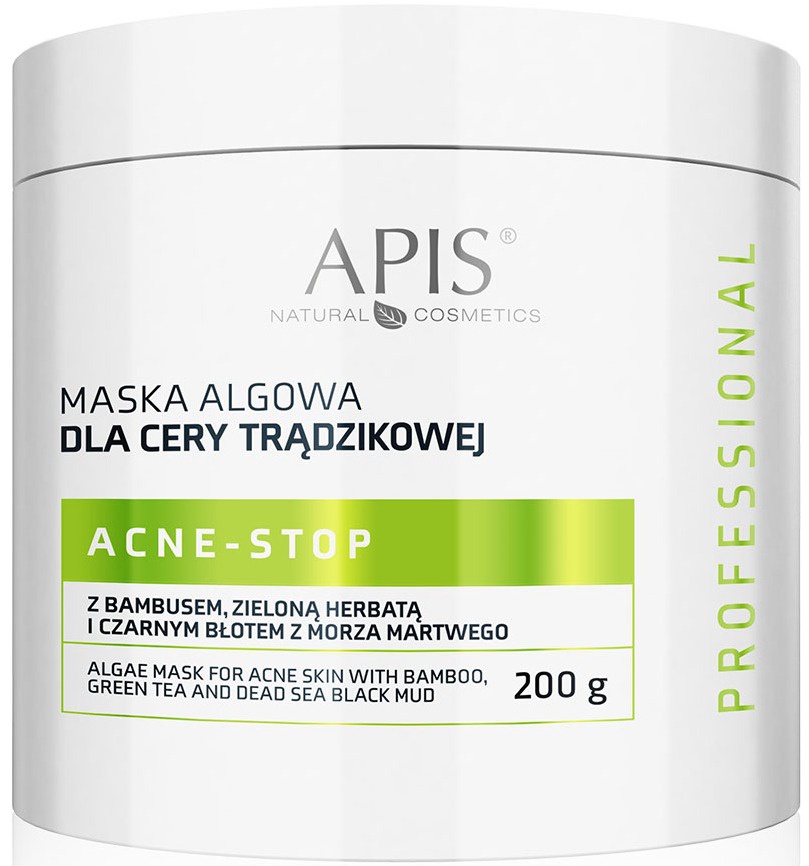
Professional Acne-Stop Algae Mask
Highlights
Other Ingredients
Skim through
| Ingredient name | what-it-does | irr., com. | ID-Rating |
|---|---|---|---|
| Solum Diatomeae (Diatomaceous Earth) | abrasive/scrub | ||
| Algin | viscosity controlling | 4, 4 | |
| Calcium Sulfate | abrasive/scrub | ||
| Tetrasodium Pyrophosphate | buffering, chelating | ||
| Trisodium Phosphate | buffering, chelating | ||
| Calcium Carbonate | abrasive/scrub, buffering | ||
| Dead Sea Mud | |||
| Bambusa Vulgaris Extract | |||
| Green Tea Extract | antioxidant, soothing | goodie | |
| Algae Extract | emollient, moisturizer/humectant | goodie | |
| Parfum | perfuming | icky |
APIS Professional Acne-Stop Algae MaskIngredients explained

A large sugar molecule (aka polysaccharide) that's used as a gelling agent and comes from brown seaweed.
Combined with calcium salts, it forms a rigid gel used in "rubber masks".





- Green tea is one of the most researched natural ingredients
- The active parts are called polyphenols, or more precisely catechins (EGCG being the most abundant and most active catechin)
- There can be huge quality differences between green tea extracts. The good ones contain 50-90% catechins (and often make the product brown and give it a distinctive smell)
- Green tea is proven to be a great antioxidant, UV protectant, anti-inflammatory, anticarcinogenic and antimicrobial
- Because of these awesome properties green tea is a great choice for anti-aging and also for skin diseases including rosacea, acne and atopic dermatitis
We have to admit that Algae Extract is not our favorite ingredient name. It does comply with the INCI standard (the official list about how ingredients on the product labels have to be called, the thing we help you to decode here :)), but there are about 20 000 different kinds of algae and an extract from them can be made in another 10 000 ways.
So, Algae Extract can be anything from La Mer's "Miracle Broth" to a simple brown algae extract that helps to smooth the hair. The official description in the Europiean Cosmetic Ingredient listing is this: "an extract of various species of Algae; Extract of the Seaweed, Fucus vesiculosus, Furaceae". Its official functions include being a humectant (helps skin to attract water), emollient (makes skin feel smooth and nice) and skin conditioner (a catchall phrase for saying it does something good for the skin).
A 2015 research paper on the potential of uses of algae in cosmetics summarizes that algae are rich sources of biologically active metabolites including antioxidants, anti-inflammatory agents, alginates, polysaccharides, and carotenoids. Currently, algae extracts are mostly used as moisturizing and thickening agents, but algae also have great potential to combat skin aging, pigmentation as well as working as an antimicrobial.
We have also browsed through Prospector to see what manufacturers say about their algae. There is, for example, an algae extract trade-named Lanablue that comes from blue-green algae (green algae is rare, less than 1% of the total macroalgae in the world) and is claimed to have retinoid like effects (i.e. reduce wrinkles, smooth skin) but without the side effects (though it seems now that the INCI name of Lanablue was changed to Aphanizomenon Flos-Aquae Extract).
There is another algae extract from another manufacturer that comes from red algae (much more common, about 40% of total macroalgae worldwide) and is claimed to have not only moisturizing but also skin smoothing and densifying effects.
Here is a brown algae extract (the most common type, about 59% of macroalgae), also just called Algae Extract on the product label that is simply claimed to be a free radical scavenger, aka antioxidant. These were just three random examples from three manufacturers all called Algae extract even though they all come from different algae with different claims.
Anyhow, the point is this; there are tons of different types of Algae Extracts out there. Unless the brand tells you what they use, it's impossible to know for sure. The most probable scenario for the Alge Extract is that it works as a moisturizer and emollient and it might have some additional anti-aging properties.
Exactly what it sounds: nice smelling stuff put into cosmetic products so that the end product also smells nice. Fragrance in the US and parfum in the EU is a generic term on the ingredient list that is made up of 30 to 50 chemicals on average (but it can have as much as 200 components!).
If you are someone who likes to know what you put on your face then fragrance is not your best friend - there's no way to know what’s really in it.
Also, if your skin is sensitive, fragrance is again not your best friend. It’s the number one cause of contact allergy to cosmetics. It’s definitely a smart thing to avoid with sensitive skin (and fragrance of any type - natural is just as allergic as synthetic, if not worse!).
You may also want to take a look at...
| what‑it‑does | abrasive/scrub |
| what‑it‑does | viscosity controlling |
| irritancy, com. | 4, 4 |
| what‑it‑does | abrasive/scrub |
| what‑it‑does | buffering | chelating |
| what‑it‑does | buffering | chelating |
| what‑it‑does | abrasive/scrub | buffering |
| what‑it‑does | antioxidant | soothing |
| what‑it‑does | emollient | moisturizer/humectant |
| what‑it‑does | perfuming |





